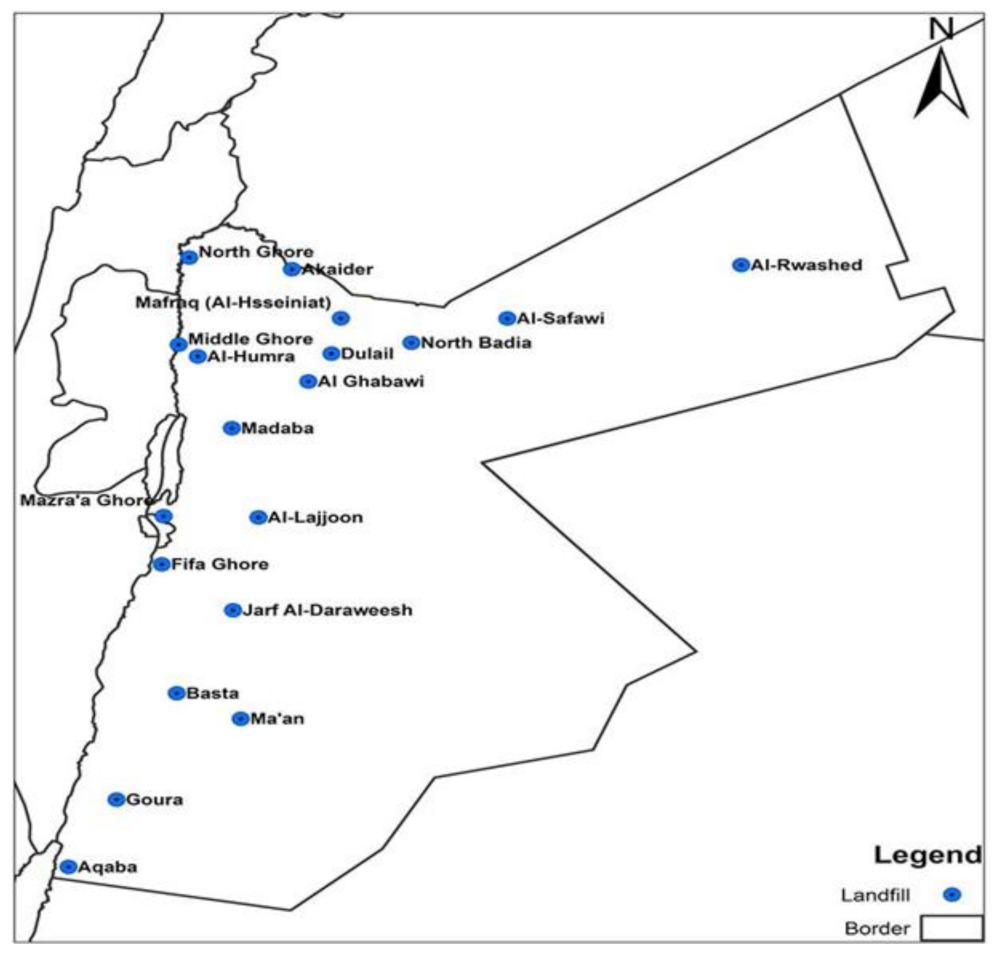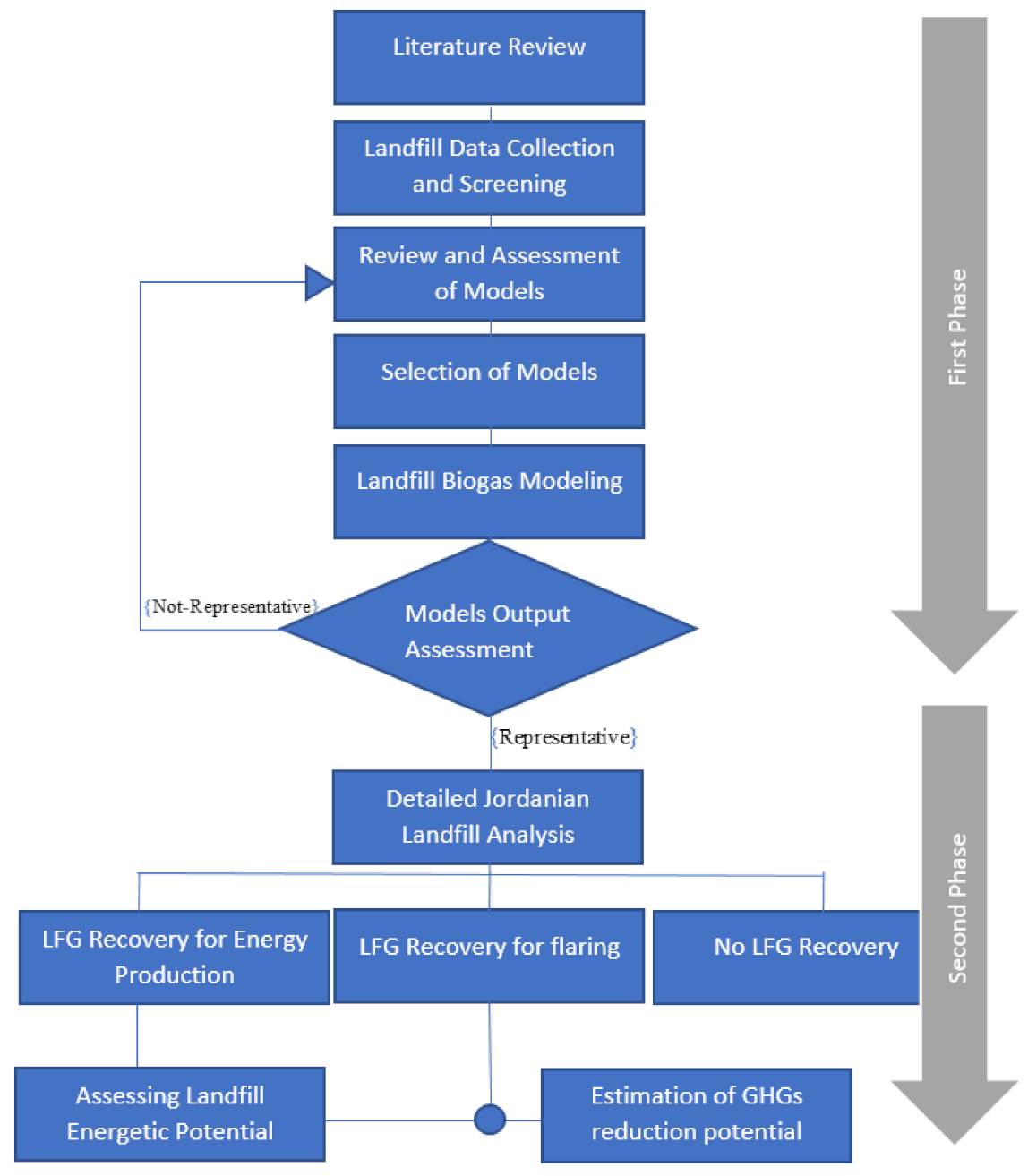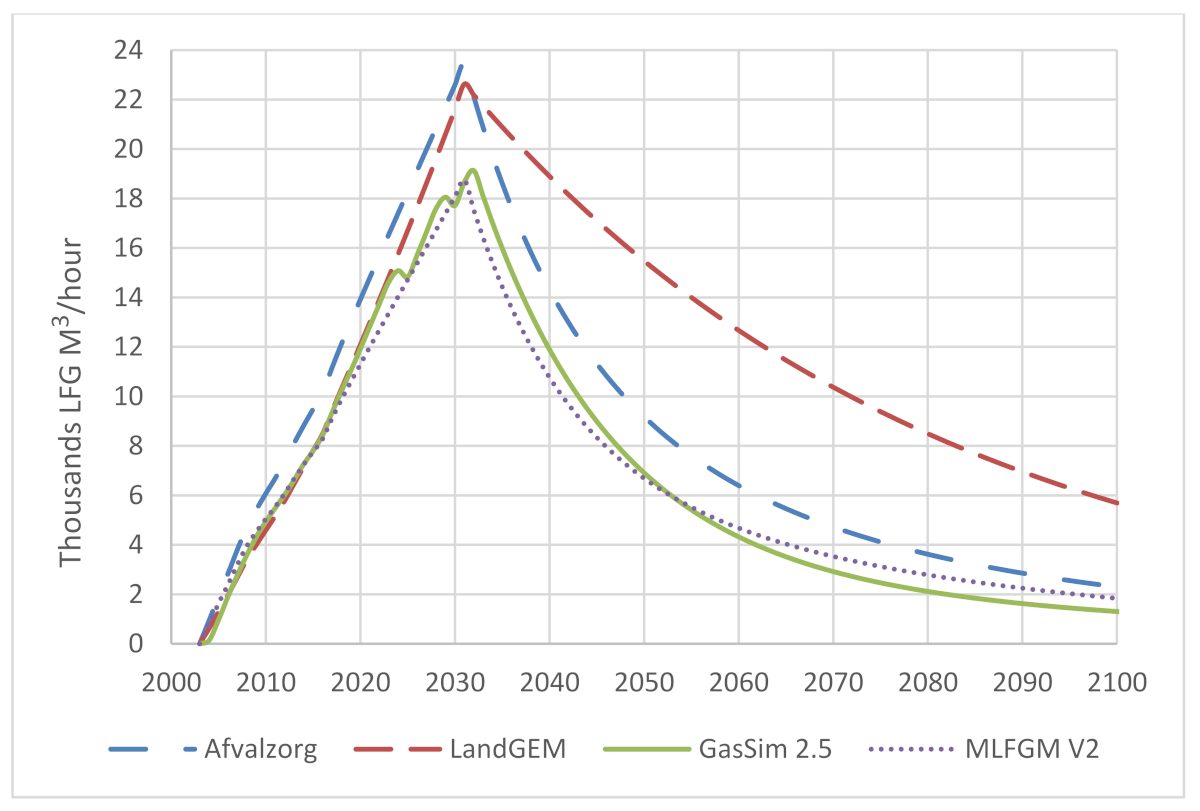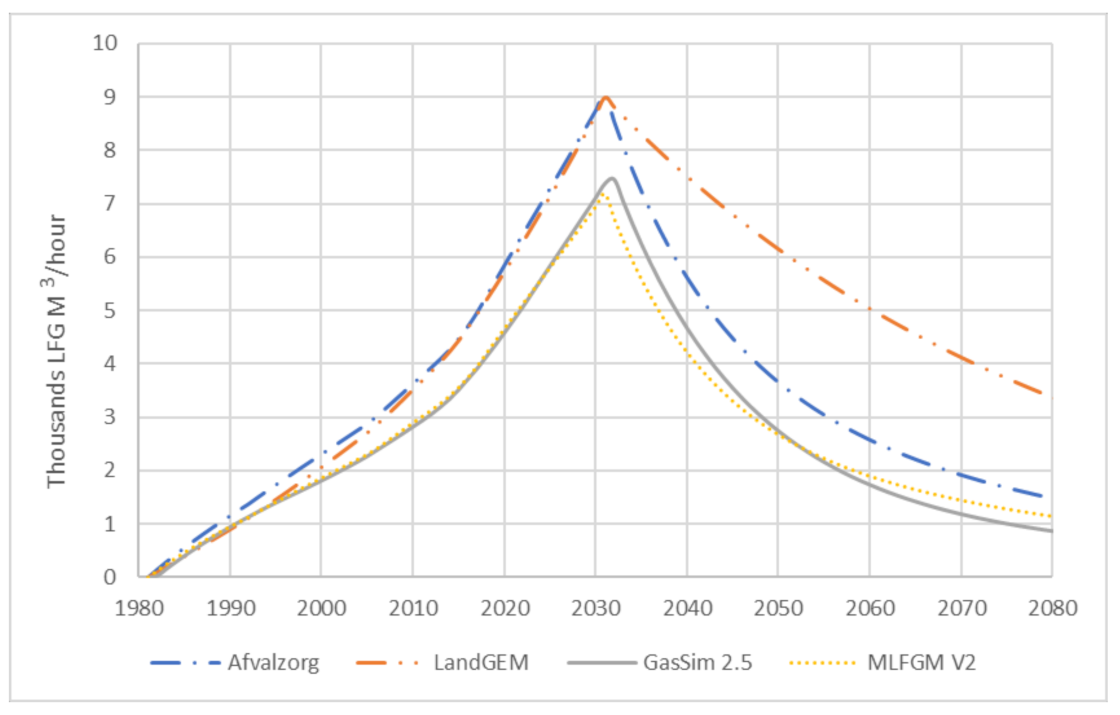Assessment of Greenhouse Gas Emissions and Energetic Potential from Solid Waste Landfills in Jordan: A Comparative Modelling Analysis
Abstract
:1. Introduction
1.1. Status of Jordan’s Energy Sector
1.2. Waste to Energy Potential
2. Methodology
- Landfill gas recovery for energy production,
- Landfill gas collection for flaring, and
- No landfill gas collection.
Landfill Gas Models
3. Results and Discussion
3.1. Landfills Screening
3.2. LFG Modelling Results
3.3. Models Verification
3.4. Energetic Potential of Jordanian Landfills
3.5. Climate Change Mitigation Potential
4. Conclusions and Recommendations
Author Contributions
Funding
Acknowledgments
Conflicts of Interest
References
- US EPA. Background Information Document for Updating AP42 Section 2.4 for Estimating Emissions from Municipal Solid Waste Landfills; EPA/600/R-08-116; U.S. Environmental Protection Agency: Washington, DC, USA, 2008. [Google Scholar]
- Abu Qdais, H.; Wuensh, C.; Dornack, C.; Nassour, A. The role of solid waste composting in mitigating climate change in Jordan. Waste Manag. Res. 2019, 37, 833–842. [Google Scholar] [CrossRef] [PubMed]
- Ministry of Municipals Affairs annual book (MoMA). Amman, Hashemite Kingdom of Jordan, 2010.
- Al-Hamamre, Z.; Saidan, M.; Hararah, M.; Rawajfeh, K.; Alkhasawneh, H.; Al Shannag, M. Wastes and biomass materials as sustainable-renewable energy resources for Jordan. Renew. Sustain. Energy Rev. 2017, 67, 295–314. [Google Scholar] [CrossRef]
- UNDP. Mitigating the Impact of the Syrian Refugee Crisis on Jordanian Vulnerable Host Communities. 2014. Available online: https://erc.undp.org/evaluation/documents/download/10354 (accessed on 18 August 2018).
- IPCC Intergovernmental Panel on Climate Change. Summary for Policymakers. In Climate Change 2013: The Physical Science Basis; 2013. [Google Scholar]
- Ministry of Environment (MOENV). Jordan’s Third National Communication on Climate Change (TNC); Ministry of Environment (MOENV): Amman, Hashemite Kingdom of Jordan, 2014. [Google Scholar]
- Manoj Chopra, D.R.; Abu-El-Shaar, W. US-Jordan Municipal Solid Waste Management Collaborative Research; The National Science Foundation: Arlington, VA, USA, 2001; p. 12. [Google Scholar]
- Nobani, H.A. Municipal Solid Waste Management at Amman City Middle East Recycling. Waste & Environmental Management Jordan. 2008. [Google Scholar]
- Ministry of Municipals Affairs (MoMA). National Solid Waste Strategy Jordan; Ministry of Municipals Affairs (MoMA): Amman, Hashemite Kingdom of Jordan, 2014. [Google Scholar]
- Ministry of Energy and mineral resources Jordan (MEMR). Ministry of Energy and Mineral Resources Jordan Annual Report; Ministry of Energy and mineral resources Jordan (MEMR): Amman, Hashemite Kingdom of Jordan, 2017. [Google Scholar]
- Abdulla, F.; Widyan, M.; Al-Ghazawi, Z.; Kiwan, S.; Abu-Qdais, H.; Hayajneh, M.; Harb, A.; Al-Nimr, M. Status of Jordan Renewable Energy Sector: Problems, Needs and Challenges. In Proceedings of the Regional Collaboration Workshop, American University of Beirut, Beirut, Lebanon, 26 April 2004. [Google Scholar]
- Ministry of Energy and Mineral Resources (MEMR). National Energy Strategy of Jordan 2015–2025, Amman Jordan, 2015. Available online: http://www.memr.gov.jo/Pages/viewpage.aspx (accessed on 30 October 2018).
- Abu Qdais, M.A.; Abu Qdais, H. A Energy content of municipal solid waste in Jordan and its potential utilization. Energy Convers. Manag. 2000, 41, 983–991. [Google Scholar] [CrossRef]
- Al-Ghazawi, Z.D.; Abdulla, F. Mitigation of methane emissions from sanitary landfills and sewage treatment plants in Jordan. Clean Technol. Environ. Policy 2008, 10, 341–350. [Google Scholar] [CrossRef]
- Abu Qdais, H.A.; Maqableh, A.M.; Al Nawayseh, L.M.; Al Jamal, N.M. Energetic and methane emission reduction potentials from an unsanitary landfill. Energy Sources Part A Recovery Util. Environ. Eff. 2011, 34, 360–369. [Google Scholar] [CrossRef]
- Abu Qdais, H.A.; Abdulla, F.; Qrenawi, L. Solid waste landfills as a source of green energy: Case study of Al Akeeder landfill. JJMIE 2010, 4, 69–74. [Google Scholar]
- Aljaradin, M. Waste-to-Energy in Jordan: Potential and Challenges. EcoMena. 2016. Available online: http://www.ecomena.org/waste-to-energy-jordan/ (accessed on 18 October 2022).
- Scharff, H.; Jacobs, J.; Oonk, H.; Hensen, A.; Afvalzorg, N.V. Methods to Ascertain Methane Emission of Landfills. 2000. Available online: https://www.afvalzorg.nl/content/uploads/2017/09/Paper-methods-to-ascertain-methane-emission.pdf (accessed on 19 October 2022).
- Thompson, S.; Sawyer, J.; Bonam, R.; Valdivia, J.E. Building a better methane generation model: Validating models with methane recovery rates from 35 Canadian landfills. Waste Manag. 2009, 29, 2085–2091. [Google Scholar] [CrossRef]
- Kamalan, H.; Sabour, M.; Shariatmadari, N. A review on available landfill gas models. J. Environ. Sci. Technol. 2011, 4, 79–92. [Google Scholar] [CrossRef]
- Mou, Z.S.; Scheutz, C.; Kjeldsen, P. Evaluating the biochemical methane potential (BMP) of low-organic waste at Danish landfills. Waste Manag. 2014, 34, 2251–2259. [Google Scholar] [CrossRef]
- Cakir, A.K.; Gunerhan, H.; Hepbasli, A. A comparative study on estimating the landfill gas potential: Modeling and analysis. Energy Sources Part A Recovery Util. Environ. Eff. 2016, 38, 2478–2486. [Google Scholar] [CrossRef]
- Majdinasab, A.; Zhang, Z.; Yuan, Q. Modelling of landfill gas generation: A review. Rev. Environ. Sci. Bio/Technol. 2017, 16, 361–380. [Google Scholar] [CrossRef]
- US EPA. Turning a Liability into an Asset: A Landfill Gas-to-Energy Project Development Handbook. Landfill Methane Outreach Program. 1996. Available online: https://nepis.epa.gov/Exe/ZyPURL.cgi?Dockey=600008CZ.txt (accessed on 19 October 2022).
- Meima, A.; Narajno, M.; Haarstrick, A. Sensitivity Analysis and Literature Review of Parameters Controlling Local Biodegradation Processes in Municipal Solid Waste Landfills. Waste Manag. 2017, 28, 904–918. [Google Scholar] [CrossRef] [PubMed]
- Barlaz, M.A.; Rooker, A.P.; Kjeldsen, P.; Gaber, M.A.; Borden, R.C. Critical Evaluation of Factors Required to Terminate the Postclosure Monitoring Period at Solid Waste Landfills. Environ. Sci. Technol. 2002, 16, 3457–3464. [Google Scholar] [CrossRef] [Green Version]
- Njoku, P.O.; Edokpayi, J.N.; Odiyo, J.O. Modeling landfill gas potential and potential energy recovery from Thohoyandou landfill site, South Africa. J. Air Waste Manag. Assoc. 2020, 70, 820–833. [Google Scholar] [CrossRef]
- Vu, H.L.; Ng, K.T.W.; Richter, A. Optimization of first order decay gas generation model parameters for landfills located in cold semi-arid climates. Waste Manag. 2017, 69, 315–324. [Google Scholar] [CrossRef] [PubMed]
- US EPA. Greenhouse Gas Equivalencies Calculator—Revision History | US EPA. 2019. Available online: https://www.epa.gov/energy/greenhouse-gas-equivalencies-calculator-revision-history (accessed on 10 July 2022).
- Amini, H.; Reinhart, D.; Mackie, K.R. Determination of first-order landfill gas modeling parameters and uncertainties. Waste Manag. 2012, 32, 305–316. [Google Scholar] [CrossRef]
- Barros, R.M.; Filho, G.L.; DaSilva, T.R. The electric energy potential of landfill biogas in Brazil. Energy Policy 2014, 65, 150–164. [Google Scholar] [CrossRef]
- Abu-Ashour, J.; Abu Qdais, H.; Al-Widyan, M. Estimation of animal and olive solid wastes in Jordan and their potential as a supplementary energy source: An overview. Renew. Sustain. Energy Rev. 2010, 14, 2227–2231. [Google Scholar] [CrossRef]
- Ayodele, T.R.; Alao, M.A.; Ogunjuyigbe, S.O. Effect of collection efficiency and oxidation factor on greenhouse gas emission and life cycle cost of landfill distributed energy generation. Sustain. Cities Soc. 2020, 52, 2020, 101821. [Google Scholar] [CrossRef]
- IPCC. Intergovernmental Panel on Climate Change. In 2006 IPCC Guidelines for National Greenhouse Gas Inventories; Institute for Global Environmental Strategies (IGES): Kanagawa, Japan, 2006; Volume 5. [Google Scholar]
- Guo, H.; Xu, H.; Liu, J.; Nie, X.; Li, X.; Shu, T.; Bai, B.; Ma, X.; Yao, Y. Greenhouse Gas Emissions in the Process of Landfill Disposal in China. Energies 2022, 15, 6711. [Google Scholar] [CrossRef]
- Kurbatova, A.; Abu-Qdais, H. Using Multi-Criteria Decision Analysis to Select Waste to Energy Technology for a Mega City: The Case of Moscow. Sustainability 2020, 12, 9828. [Google Scholar] [CrossRef]
- Al Theeb, N.; Abu Qdais, H.; Abu Qdais, F.; Habibah, O. Utilizing AHP-TOPSIS as Multi-Criteria Decision Approaches to Select the Best Alternative for Waste to Energy Technology. Jordan J. Mech. Ind. Eng. 2022, 16, 601–613. [Google Scholar]





| Urbanization Index Component | 0–50% | 50–75% | 75–100% |
|---|---|---|---|
| Organics | 0.65 | 0.57 | 0.50 |
| Paper/Cardboard | 0.09 | 0.13 | 0.15 |
| Plastics | 0.09 | 0.13 | 0.15 |
| Metal | 0.02 | 0.03 | 0.04 |
| Glass | 0.02 | 0.03 | 0.04 |
| Textile | 0.03 | 0.01 | 0.01 |
| Wood/Garden | 0.05 | 0.02 | 0.01 |
| Miscellaneous | 0.05 | 0.08 | 0.10 |
| Governorates | Mafraq, Kerak | Jarash, Madaba, Balqa, Tafilah, Ma’an | Amman, Irbid, Ajloun, Az-Zarqa, Aqaba |
| Landfill Name | Score | Screening Result |
|---|---|---|
| Al-Akaider | 100 | LFG collection for energy recovery |
| Al-Ghabawi | 100 | |
| Al-Hsseiniat | 40 | |
| Al-Lajjoon | 40 | |
| Madaba | 40 | |
| North Ghore | 30 | Collection and flaring of LFG |
| Al-Humra | 30 | |
| Deir Alla | 30 | |
| Al-Dulail | 30 | |
| North Badia | 15 | Not suitable for energy recovery or flaring |
| Aqaba | 15 | |
| Al-Mohamadeah | 10 | |
| Basta (Ail dumpsite) | 10 | |
| Ma’an | 10 | |
| Jarf Al-Daraweesh | 10 | |
| Al-Qawiera | 10 | |
| Al-Barkah | 10 | |
| Al-Samar | 10 |
| Landfill | Landfilled Waste Amount by 2030 | Estimated Collection Efficiency | Power Generation Capacity 2020–2030 |
|---|---|---|---|
| Al-Ghabawi landfill | 37 million tons | 85% efficiency | 18 MW |
| Al-Akeeder landfill | 16.5 million tons | 75% efficiency | 6.5 MW |
| Al-Hsseiniat Landfill | 10 million tons | 70% efficiency | 4 MW |
| Al-Lajjoon Landfill | 9.5 million tons | 65% efficiency | 3.75 MW |
| Madaba Landfill | 7.6 million tons | 65% efficiency | 2.6 MW |
Disclaimer/Publisher’s Note: The statements, opinions and data contained in all publications are solely those of the individual author(s) and contributor(s) and not of MDPI and/or the editor(s). MDPI and/or the editor(s) disclaim responsibility for any injury to people or property resulting from any ideas, methods, instructions or products referred to in the content. |
© 2022 by the authors. Licensee MDPI, Basel, Switzerland. This article is an open access article distributed under the terms and conditions of the Creative Commons Attribution (CC BY) license (https://creativecommons.org/licenses/by/4.0/).
Share and Cite
Abu-Qdais, H.A.; Al-Ghazawi, Z.; Awawdeh, A. Assessment of Greenhouse Gas Emissions and Energetic Potential from Solid Waste Landfills in Jordan: A Comparative Modelling Analysis. Water 2023, 15, 155. https://doi.org/10.3390/w15010155
Abu-Qdais HA, Al-Ghazawi Z, Awawdeh A. Assessment of Greenhouse Gas Emissions and Energetic Potential from Solid Waste Landfills in Jordan: A Comparative Modelling Analysis. Water. 2023; 15(1):155. https://doi.org/10.3390/w15010155
Chicago/Turabian StyleAbu-Qdais, Hani A., Ziad Al-Ghazawi, and Abdallah Awawdeh. 2023. "Assessment of Greenhouse Gas Emissions and Energetic Potential from Solid Waste Landfills in Jordan: A Comparative Modelling Analysis" Water 15, no. 1: 155. https://doi.org/10.3390/w15010155





